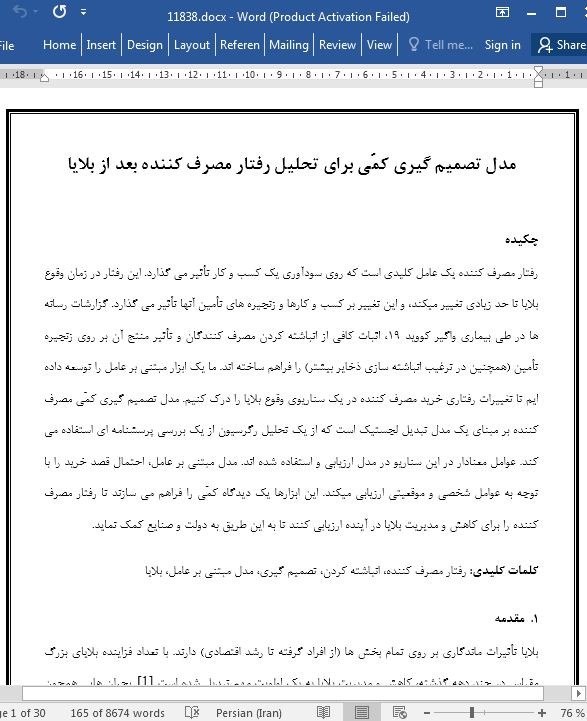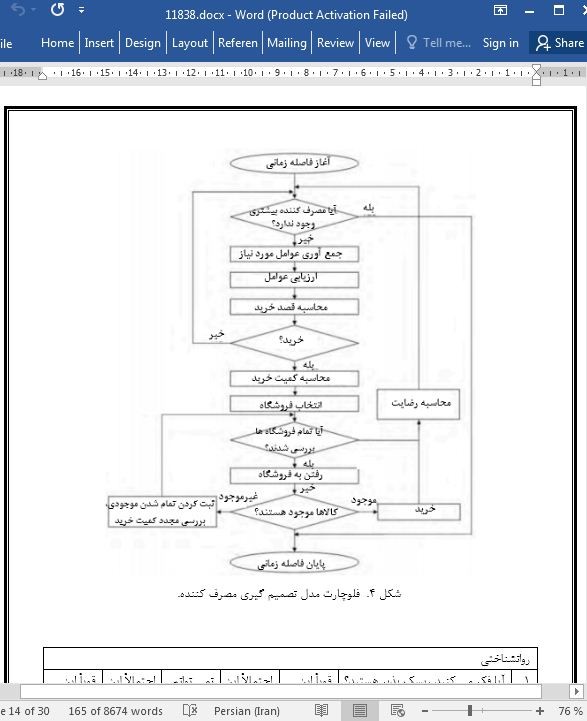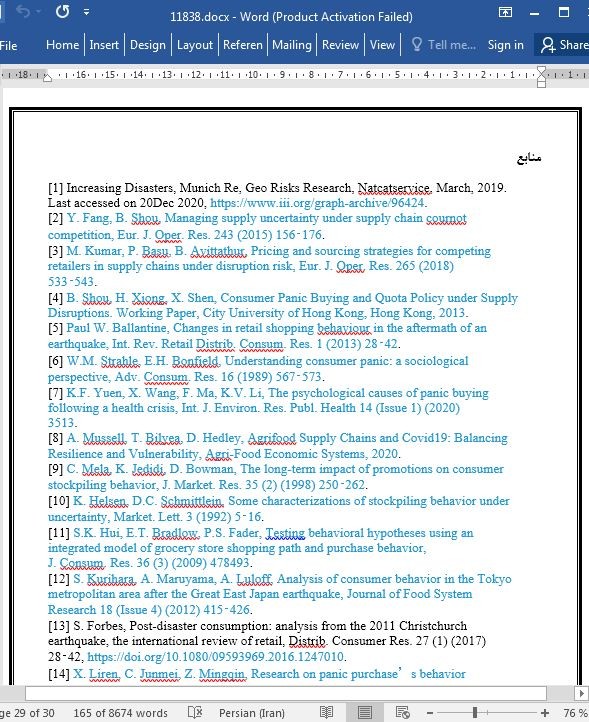
مدل تصمیم گیری کمی برای تحلیل رفتار مصرف کننده بعد از بلایا
چکیده
رفتار مصرف کننده یک عامل کلیدی است که روی سودآوری یک کسب و کار تأثیر می گذارد. این رفتار در زمان وقوع بلایا تا حد زیادی تغییر میکند، و این تغییر بر کسب و کارها و زنجیره های تأمین آنها تأثیر می گذارد. گزارشات رسانه ها در طی بیماری واگیر کووید 19، اثبات کافی از انباشته کردن مصرف کنندگان و تأثیر منتج آن بر روی زنجیره تأمین (همچنین در ترغیب انباشته سازی ذخایر بیشتر) را فراهم ساخته اند. ما یک ابزار مبتنی بر عامل را توسعه داده ایم تا تغییرات رفتاری خرید مصرف کننده در یک سناریوی وقوع بلایا را درک کنیم. مدل تصمیم گیری کمّی مصرف کننده بر مبنای یک مدل تبدیل لجستیک است که از یک تحلیل رگرسیون از یک بررسی پرسشنامه ای استفاده می کند. عوامل معنادار در این سناریو در مدل ارزیابی و استفاده شده اند. مدل مبتنی بر عامل، احتمال قصد خرید را با توجه به عوامل شخصی و موقعیتی ارزیابی میکند. این ابزارها یک دیدگاه کمّی را فراهم می سازند تا رفتار مصرف کننده را برای کاهش و مدیریت بلایا در آینده ارزیابی کنند تا به این طریق به دولت و صنایع کمک نماید.
1. مقدمه
بلایا تأثیرات ماندگاری بر روی تمام بخش ها (از افراد گرفته تا رشد اقتصادی) دارند. با تعداد فزاینده بلایای بزرگ مقیاس در چند دهه گذشته، کاهش و مدیریت بلایا به یک اولویت مهم تبدیل شده است [1]. بحران هایی همچون زلزله بزرگ شرق ژاپن ، زلزله کرایست چرچ ، گردباد کاترینا، و اخیراً هم بیماری واگیر کووید 19، تأثیرات شدیدی بر روی اقتصادهای جهانی و همچنین زندگی میلیون ها نفر داشته اند و تغییرات جدی را در سبک زندگی افراد ایجاد نموده اند. وقوع این رویدادها، اهمیت ابزارهای سنجش کاهش به منظور کاهش دادن تلفات انسانی و اقتصادی را اثبات نموده است. افراد به شکل خستگی ناپذیری تلاش کرده اند که این تأثیرات و خسارات را کاهش دهند، و ابزارهای سنجش و روشهای کاهشی را توسعه دهند که یک بازیابی سریع بعد از بلایا را ممکن سازند.
6. نتیجه گیری ها
ما یک مدل شبیه سازی مبتنی بر عامل را توسعه داده ایم تا تغییرات در رفتار خرید مصرف کنندگان در حین وقوع بلایا را درک کنیم. ما یک مدل تصمیم گیری کمّی را اجرا نمودیم تا با توجه به عوامل شخصی و موقعیتی، احتمال رفتار انباشته کردن در بین مصرف کنندگان را محاسبه کنیم؛ ما این کار با استفاده از یک تحلیل رگرسیون چندگانه از یک بررسی پرسشنامه ای انجام دادیم. تغییرات در رفتار مصرف کننده در طی یک بلا را می توان با استفاده از این مدل مشاهده کرد؛ این کار از طریق تعیین موقعیت های مختلف – همچون اعمال محدودیت توسط چند فروشگاه، گزارشات کمبود زیاد، و غیره – انجام می شود. این مدل را در مدل شبیه سازی زنجیره تأمین می توانیم اجرا کنیم تا پاسخ و تأثیرات رفتار انباشته کردن مصرف کننده به زنجیره تأمین را محاسبه کنیم و روشهای کاهش مختلف را آزمایش نماییم و به این طریق اختلالات را کاهش دهیم یا از وقوع آنها جلوگیری کنیم.
Abstract
Consumer behavior is a key factor that affects the profitability of a business. It is altered significantly in disaster times, which affects the businesses and their supply chains. The media reports during the recent COVID19 pandemic has provided adequate proof of consumer stockpiling and its consequential effects on the supply chain, also in fuelling additional stockpiling. We have developed an agent-based tool to understand consumer purchase behavioral changes in a disaster scenario. The quantitative consumer decision-making model is based on a logistic transformation model using a regression analysis of a questionnaire survey. The significant factors in the scenario have been assessed and employed in the model. The agent-based model evaluates the purchase intention probability, given the personal and situational factors. Such tools give a quantitative perspective to evaluate consumer behavior for future disaster mitigation and management to help the government and the industries.
1. Introduction
Disasters have lasting effects on all sectors, from people to economic growth. Disaster mitigation and management have risen to a priority with the increasing number of large-scale disasters in the past few decades [1]. Crises such as the Great East Japan earthquake, the Christchurch earthquake, hurricane Katrina, and more recently the COVID-19 pandemic had a severe impact on global economies and also on the lives of millions of people, with drastic changes in their lifestyles. The occurrence of such events has shown the importance of mitigation measures in order to alleviate the resulting human and economic loss. People have been tirelessly trying to reduce the impact and damage by developing mitigation measures and methods which enable a speedy post-disaster recovery.
6. Conclusions
An agent-based simulation model has been developed to understand the changes in the purchase behavior of a consumer when a disaster occurs. A quantitative decision-making model has been implemented to calculate the stockpiling probability of the consumers, given the personal and situational factors, using a logistic transformation model based on a multiple regression analysis of a questionnaire survey. The changes in consumer behavior during a disaster can be observed, using this model, by setting various situations, such as a few stores employing restrictions, a lot of shortage reports, etc. This model can be implemented in the supply chain simulation model to calculate the response and effects of consumer stockpiling on the supply chain and test various mitigation methods to reduce or avoid disruptions.
چکیده
1. مقدمه
2. مدل مصرف کننده
2.1 عامل مصرف کننده
2.2 سناریوی شبیه سازی فازبندی شده
2.3 فرآیند تصمیم گیری مصرف کننده
3. خروجی های تحلیل رگرسیون
4. نتایج شبیه سازی مقدماتی
4.1 اعتبارسنجی
4.2 تغییر رفتار مصرف کننده
5. بحث
6. نتیجه گیری ها
منابع
Abstract
1. Introduction
2. Consumer model
2.1. Consumer agent
2.2. Phased simulation scenario
2.3. Consumer decision-making process
3. Regression analysis outputs
4. Preliminary simulation results
4.1. Validation
4.2. Consumer behavioral transformation
5. Discussion
6. Conclusions
Declaration of competing interest
References
Further reading
- ترجمه فارسی مقاله با فرمت ورد (word) با قابلیت ویرایش، بدون آرم سایت ای ترجمه
- ترجمه فارسی مقاله با فرمت pdf، بدون آرم سایت ای ترجمه



